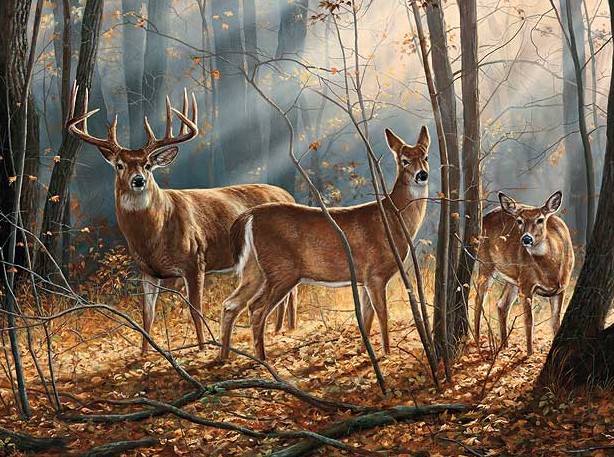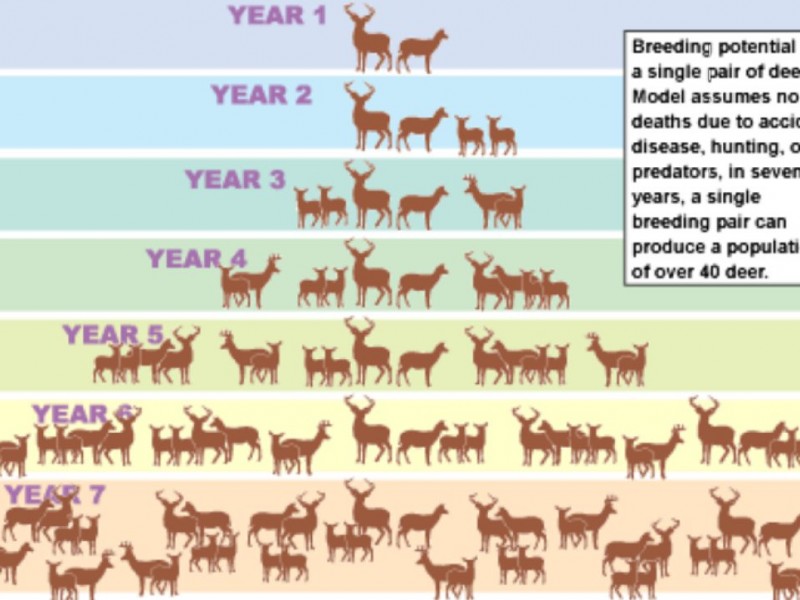08 Jan SHOULD DOES WITH FAWNS BE TARGETTED?
Late season hunts are often for Does or cow elk. In some cases, crop depredation tags are issued by the state to reduce herd sizes in certain areas. Late season deer need 40 pounds of grass a day to survive. Winter wheat, hay bales, and future grass crops can get hammered when deer herd up for the Winter.

One a hunt a few seasons ago, I was on stand waiting to fill a doe tag. Several deer came in range with 3 large, dominant does. Most bucks have moved away from doe herds after the Rut. Small yearling bucks may still be close to their Mothers along with yearling fawns and does.
Since does breed at different times during a pre-rut, Rut, or Post Rut, births are also staggered. Late births mean small deer, as they survive into the winter.
I noticed that the doe groups contained mature Mothers and pairs of yearling twins. All the yearlings were small. So, what do I shoot?
Does, at this time of year, are no longer nursing and the Fawn’s spots are gone. These yearlings were maybe 60 pounds on the hoof. Once dressed and butchered, you may have gotten 20-25 pounds of meat from them. Is this even worth it?
Most does have been bred at this time of the year. The mothers have guided their fawns through a hunting season and introduced them to life. It takes a doe 200 days, from the time they are bred, until they drop a fawn. These new deer keep their spots for 3-4 months. The small Does that I was looking at were less than 10 months old.
I passed on the shot. If I shot the mother, the family group would be at risk or need to be adopted by another Doe. After harvesting deer for a lifetime, it has become harder to pull the trigger. Antlers and bragging rights do not matter to me. I do enjoy the meat.
It is true that small fawns taste great! Mountain Men and Native Peoples targeted them. Camp meat was about portion size. A small deer would easily fit on a spit for dinner.
The truth is that harvesting small does is fine. Hunting today is about managing a healthy population. Deer multiply quickly. Annual harvest of 50% can still result in an increasing deer population. Whether this deer is your first or most recent, it is Biologically acceptable to harvest a small deer.
More harvested deer means fewer deer to over graze a habitat, less deer on the roadway, and fewer deer feasting on your shrubbery. If the landowner, or managers, strive for a certain population with specific genetics, specific targeting is important. If Doe harvesting is to occur, a guide, or representative of the farm needs to approve the shots.
Too much Doe harvest can destroy the overall deer gene pool and population size. This is also important with Bucks.
Cull deer refers to the deer that can be removed from a herd. An experienced Manager can identify the appropriate Culls. On a confined Game Farm, this is often done over bait piles. Deer can be selected after thorough observation and identification.
Rut is when deer mate. When the Does become in heat, they are often bred by several bucks. Maybe the first buck was the most desirable. Due to Biological timing, perhaps the last inferior buck fathers the fawns. Bucks roam great distances during the Rut. Neighboring properties, where no management happens, can cross breed with managed deer. Even with high fences, Bucks find a way.
Young fawns will learn to survive from any group of Does. It is common for a Mother, or dominant Doe to take over a fawn’s education, if the fawn is orphaned. Deer are creatures that find security and safety in numbers. 10 Does means 20 eyes, nostrils, and ears.
There is also the thought that “only the tough survives.” If a Doe is harvested, the Fawn will figure it out. If not, then Nature knows best. Some people find fawns in the wild and make them into pets. One small buck was made a family pet near the Gettysburg Battlefield. The farm was near Little Round Top. A woman was jogging up the slope when she was attacked by this confused Buck. The Buck had jumped the fence and was a strong 10-point. He gored and injured the jogger to the point that she could not stand. A National Park Ranger had to shoot the enraged Buck to save the woman’s life.
Other deer are often fed and befriended by humans. They enjoy seeing the deer in their yard. Deer stack up by the dozens where they can become crowded. Nose to nose. Feces, and urine contact spreads diseases in a hurry. I guess what I am saying is that a Fawn surviving, or not, after being orphaned is a more natural outcome than too much Human control. A Fed Deer is a Dead deer! It is important to keep wild game populations wild.

Natural predators have changed. There are fewer or no bears, wolves, or other classic predators have been removed. Coyotes have become a major predator. Wild dogs are also a newer predator. Small, injured, or sick deer are the first to be preyed upon. After predators, highways are responsible for predation. Disease and sickness reduce populations. All these predators are indiscriminate. When populations get too large, these killers will take control.
Healthy populations, in healthy habitats easily survive. Many of these habitats are supported by hunters. Not allowing hunters to be management tools is a huge mistake. Yearly, selective harvests are essential to maintaining quality herds.
Harvesting a deer is a personal choice. Later the same day, 5 larger does walked past my stand. All were 2-5 years old. I targeted the biggest Doe and pulled the trigger. Which deer you shoot is a personal choice. If the hunt is ethical, legal, and honest, then the harvest will always be a trophy.
Aim small, miss small!
Montana Grant
For more Montana Grant, target him at www.montanagrantfishing.com.

